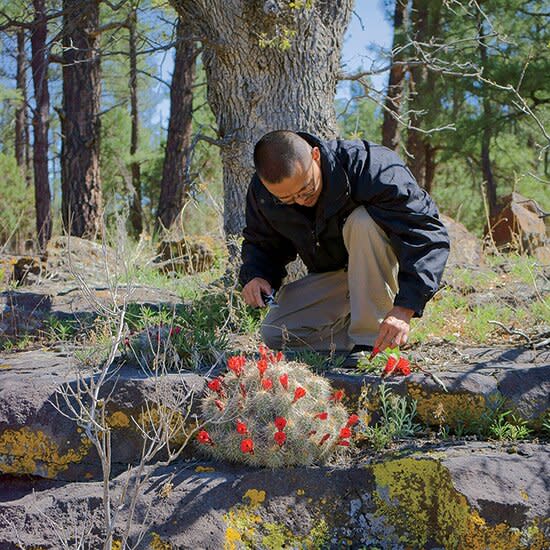Will Native American Cuisine Ever Get Its Due?

In summer's copper twilight, Apache chef Nephi Craig collects wild tea from the foothills of Arizona's White Mountains, just as he has every year since he was a boy. Like generations of Apache before him, Craig gathers it in a deliberate, contemplative way—careful never to pull it up by the roots, so it will grow back. For centuries, Apache have steeped these tawny stalks to brew a reddish-orange drink that helps cure colds and connects their people to the traditions of their ancestors. But Craig uses wild tea and other foraged flora to create a different kind of link—one between this isolated corner of Native American country and the wider culinary world.
As he fills his basket, Craig climbs to 10,000 feet, an elevation from which he can take in the peaks and valleys of the mountain range where Apache have always collected, cooked and eaten the plants they found. Finally, he reaches Summit Restaurant at the Sunrise Park Resort Hotel, where he uses foraged ingredients in his remarkable tasting menus—his pioneering take on Native American cuisine.
Cooking with a sense of place and with wild ingredients from the surrounding landscape are principles the 34-year-old Craig shares with proponents of the New Nordic movement, led by René Redzepi at Copenhagen's Noma. Foraging may be a new idea for many chefs, but it is an ancient Native American practice. "When I was a kid, no one called this foraging," Craig says. "Instead, I was told, 'This is tea; those are sumac berries.' It was natural." But Craig credits the New Nordic movement with the growing interest in Native cuisine. Blaine Wetzel, for instance, a chef who worked at Noma, depends on Native tradition for the menu at his Washington state restaurant, The Willows Inn, on Lummi Island. "The island has unique edible plants," Wetzel says. "The indigenous people here know which ones to eat and when to eat them."
Craig grew up on White Mountain Apache land: "my base—where I was born, and where my umbilical cord is buried," he says. As a high schooler, he loved Great Chefs of the World on the Discovery Channel. The show introduced him to culinary legends like Alain Passard and Daniel Boulud. "I felt like I could do what they did," Craig says. "I had no idea what being a chef meant. I had to learn for myself."
Craig graduated from culinary school in 2000 and worked his way up at Mary Elaine's, a venerable, now-closed French restaurant in Scottsdale, Arizona. His training continued in kitchens all over the world—London, Osaka, Cologne, São Paulo—before he returned to the White Mountains and his interest turned to the edible landscape around him.
Summer in the pine forest of the White Mountains brings an abundance of meadow rue, a peppery wild plant Craig picks when it's young and tender. And there's edible sumac, a sour red berry that he steeps in water for a tart, refreshing pink beverage. "When I was a kid, I would eat the berry on the spot," he says. Craig also fills his basket with juniper berries, acorns, gooseberries, strawberries and oxalis, a wild leaf that tastes like a sour green apple.
At Summit, Craig serves a standard pub menu in the main dining room, but at the round Chef's Table that he squeezes into his kitchen, he uses pre-Columbian ingredients, both foraged and cultivated, to create elegant dinners that explore his version of what Native American cuisine can be. Here, he serves the oxalis he picked as a garnish for an elegant cold melon soup. Occasionally, he'll make gah, a seared rack of rabbit. Rabbit is a common Native protein, and here, it's perched on top of roasted onion with a vibrant green parsley sauce that Craig calls Sauce Nana, after a historic Apache warrior. He serves the dish on a bed of river stones from the Salt River Canyon to impart a "sense of place."
The interplay between traditional and modern is what makes Craig's menu fascinating. Some dishes appear under their romanized Apache names: The gazpacho-esque chilled tomato soup with quinoa and mint, for instance, is Itoo' Chínk'ózhé, Sik'az. Those words tell a story—one about the time when tomatoes went by a different name and ancient culinary geniuses made use of their deliciousness.
Craig's quest to bring Native cuisine to prominence—a mission he shares with like-minded chefs in the Native American Culinary Association that he founded in 2003—is going to take time. But one of his early acolytes is his 10-year-old son, Ari. Like many kids, Ari is into baseball and soccer, but with the persuasive power of a Google search, Craig piqued his son's interest in their shared culinary history. "I sat Ari down in front of the computer and said, 'Look at these chefs in Denmark and New York doing what they call foraging,' " Craig says. " 'We've done that for generations, and now people all over the world are doing it, too.' "
RELATED: Foraging Wisdom for Everyone
